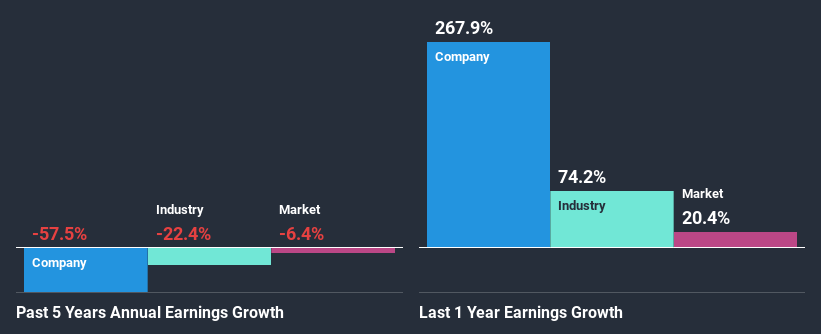- Saudi Arabia
- /
- Basic Materials
- /
- SASE:2360
Does Saudi Vitrified Clay Pipe co.'s (TADAWUL:2360) Weak Fundamentals Mean That The Market Could Correct Its Share Price?

Saudi Vitrified Clay Pipe (TADAWUL:2360) has had a great run on the share market with its stock up by a significant 70% over the last three months. However, in this article, we decided to focus on its weak fundamentals, as long-term financial performance of a business is what ultimatley dictates market outcomes. Specifically, we decided to study Saudi Vitrified Clay Pipe's ROE in this article.
Return on equity or ROE is a key measure used to assess how efficiently a company's management is utilizing the company's capital. In other words, it is a profitability ratio which measures the rate of return on the capital provided by the company's shareholders.
See our latest analysis for Saudi Vitrified Clay Pipe
How To Calculate Return On Equity?
ROE can be calculated by using the formula:
Return on Equity = Net Profit (from continuing operations) ÷ Shareholders' Equity
So, based on the above formula, the ROE for Saudi Vitrified Clay Pipe is:
4.8% = ر.س14m ÷ ر.س294m (Based on the trailing twelve months to September 2020).
The 'return' refers to a company's earnings over the last year. One way to conceptualize this is that for each SAR1 of shareholders' capital it has, the company made SAR0.05 in profit.
What Is The Relationship Between ROE And Earnings Growth?
We have already established that ROE serves as an efficient profit-generating gauge for a company's future earnings. We now need to evaluate how much profit the company reinvests or "retains" for future growth which then gives us an idea about the growth potential of the company. Assuming all else is equal, companies that have both a higher return on equity and higher profit retention are usually the ones that have a higher growth rate when compared to companies that don't have the same features.
Saudi Vitrified Clay Pipe's Earnings Growth And 4.8% ROE
As you can see, Saudi Vitrified Clay Pipe's ROE looks pretty weak. Even when compared to the industry average of 9.1%, the ROE figure is pretty disappointing. For this reason, Saudi Vitrified Clay Pipe's five year net income decline of 57% is not surprising given its lower ROE. We believe that there also might be other aspects that are negatively influencing the company's earnings prospects. For example, the business has allocated capital poorly, or that the company has a very high payout ratio.
As a next step, we compared Saudi Vitrified Clay Pipe's performance with the industry and found thatSaudi Vitrified Clay Pipe's performance is depressing even when compared with the industry, which has shrunk its earnings at a rate of 22% in the same period, which is a slower than the company.

The basis for attaching value to a company is, to a great extent, tied to its earnings growth. The investor should try to establish if the expected growth or decline in earnings, whichever the case may be, is priced in. Doing so will help them establish if the stock's future looks promising or ominous. If you're wondering about Saudi Vitrified Clay Pipe's's valuation, check out this gauge of its price-to-earnings ratio, as compared to its industry.
Is Saudi Vitrified Clay Pipe Making Efficient Use Of Its Profits?
With a three-year median payout ratio as high as 171%,Saudi Vitrified Clay Pipe's shrinking earnings don't come as a surprise as the company is paying a dividend which is beyond its means. Its usually very hard to sustain dividend payments that are higher than reported profits. Our risks dashboard should have the 2 risks we have identified for Saudi Vitrified Clay Pipe.
Additionally, Saudi Vitrified Clay Pipe has paid dividends over a period of at least ten years, which means that the company's management is determined to pay dividends even if it means little to no earnings growth.
Conclusion
On the whole, Saudi Vitrified Clay Pipe's performance is quite a big let-down. Specifically, it has shown quite an unsatisfactory performance as far as earnings growth is concerned, and a poor ROE and an equally poor rate of reinvestment seem to be the reason behind this inadequate performance. Until now, we have only just grazed the surface of the company's past performance by looking at the company's fundamentals. To gain further insights into Saudi Vitrified Clay Pipe's past profit growth, check out this visualization of past earnings, revenue and cash flows.
If you decide to trade Saudi Vitrified Clay Pipe, use the lowest-cost* platform that is rated #1 Overall by Barron’s, Interactive Brokers. Trade stocks, options, futures, forex, bonds and funds on 135 markets, all from a single integrated account. Promoted
New: Manage All Your Stock Portfolios in One Place
We've created the ultimate portfolio companion for stock investors, and it's free.
• Connect an unlimited number of Portfolios and see your total in one currency
• Be alerted to new Warning Signs or Risks via email or mobile
• Track the Fair Value of your stocks
This article by Simply Wall St is general in nature. It does not constitute a recommendation to buy or sell any stock, and does not take account of your objectives, or your financial situation. We aim to bring you long-term focused analysis driven by fundamental data. Note that our analysis may not factor in the latest price-sensitive company announcements or qualitative material. Simply Wall St has no position in any stocks mentioned.
*Interactive Brokers Rated Lowest Cost Broker by StockBrokers.com Annual Online Review 2020
Have feedback on this article? Concerned about the content? Get in touch with us directly. Alternatively, email editorial-team (at) simplywallst.com.
About SASE:2360
Saudi Vitrified Clay Pipe
Manufactures and sells vitrified clay pipes and fittings in Saudi Arabia and internationally.
Mediocre balance sheet minimal.
Market Insights
Community Narratives



